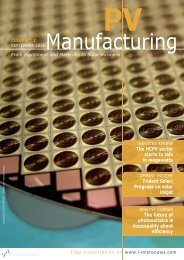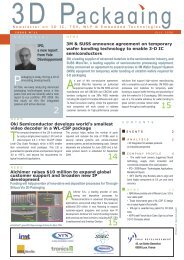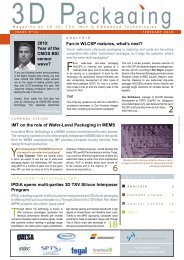issue n°139 - I-Micronews
issue n°139 - I-Micronews
issue n°139 - I-Micronews
You also want an ePaper? Increase the reach of your titles
YUMPU automatically turns print PDFs into web optimized ePapers that Google loves.
12 | ISSUE N°139 | 7/02/13<br />
PHOTOVOLTAICS<br />
Phoenix Solar completes flagship project in Saudi<br />
Arabia<br />
Ground-mounted solar power plant with a peak power of 3.5 megawatts.<br />
The installation is equipped by 12,684 crystalline silicon PV modules<br />
supplied by Suntech and is owned by Saudi Arabian oil company Saudi<br />
Aramco.<br />
Phoenix Solar, an international<br />
photovoltaic system integrator listed<br />
in Prime Standard of the Frankfurt<br />
Stock Exchange, has successfully taken its<br />
flagship project in Saudi Arabia into<br />
operation. The ground-mounted<br />
photovoltaic plant with a peak power of 3.5<br />
megawatts is located in Riyadh on the<br />
premises of KAPSARC (King Abdullah<br />
Petroleum Studies and Research Center),<br />
home to the world’s largest oil research<br />
facility. The solar power plant is part of the<br />
US Green Building Council’s LEED<br />
Certification (Leadership in Energy and<br />
Environmental Design) which KAPSARC<br />
aims to achieve. This certification is proof<br />
of compliance with the demanding<br />
requirements and standards placed on<br />
sustainable and green building.<br />
Over the last 20 months, Phoenix Solar has<br />
installed more than 12,000 Suntech Power<br />
crystalline modules on an area of 55,000<br />
square meters. The German company SMA<br />
supplied the central inverters. The<br />
expected energy yield amounts to around<br />
5,800 megawatt hours and is fed directly<br />
into KAPSARC’s medium voltage grid.<br />
This project in the Saudi Arabian desert<br />
presented many challenges, as there is<br />
little research available so far on the<br />
performance of solar power plants in desert<br />
regions. Phoenix has developed a special<br />
solution to accommodate the high<br />
temperatures and sand storms: the<br />
photovoltaic array boxes, which normally<br />
stand in the field array, were placed in a<br />
well insulated, air-conditioned inverter<br />
building. This approach considerably<br />
improves the conditions under which the<br />
power plant can be maintained as well as<br />
prolonging its life cycle. The engineers and<br />
technicians of Phoenix Solar have<br />
incorporated the demanding requirements<br />
based on the Saudi Aramco Standards into<br />
the planning, electrical work, air<br />
conditioning technology and lighting. Saudi<br />
Aramco as the Project Management<br />
Consultant was responsible for the whole<br />
project on behalf of KAPSARC.<br />
www.phoenixsolar-group.com<br />
Intevac receives first production order for ENERGi<br />
Ion Implant system for solar industry<br />
The compact ion implant ENERGi system meets the cost, efficiency and<br />
productivity requirements of solar cell manufacturing and is the most costeffective<br />
doping solution.<br />
Intevac. announced that it has received an<br />
order for an Ion Implant ENERGi system,<br />
scheduled to ship in the first quarter of<br />
2013. ENERGi incorporates enabling<br />
technologies that align with solar industry cost<br />
reduction roadmap and is extendible to<br />
accommodate future advanced cell<br />
architectures and efficiency requirements.<br />
www.intevac.com<br />
ENERGi implant tool (Courtesy of Intevac)<br />
EMCORE delivers 1 Millionth solar cell to Space<br />
Systems/Loral<br />
EMCORE has been supplying Space Systems/Loral with high-efficiency,<br />
multi-junction solar cells for more than 10 years.<br />
Solar wafer start-up 1366 Technologies opens<br />
new production-scale factory<br />
The new production facility is based on the Direct Wafer technology and<br />
has the annual production capacity of 25 MW.<br />
The company’s new facility includes PV<br />
cell processing equipment for testing<br />
and validation of its wafer technology.<br />
On January 30th, 2013 start-up 1366<br />
Technologies (Bedford, Massachusetts, US)<br />
opened a new production facility based on its<br />
Direct Wafer technology in the US state of<br />
Massachusetts, with the ability to reach up to<br />
25 MW of annual production capacity.<br />
The Direct Wafer process forms ultra-thin<br />
multicrystalline silicon wafers directly from<br />
molten silicon, removing several steps in<br />
conventional production processes. The<br />
factory also contains 1366’s research and<br />
development operations.<br />
The new factory includes processes to turn<br />
the company’s wafers into solar photovoltaic<br />
(PV) cells, allowing internal testing and<br />
validation.<br />
1366 notes that in customer trials, its cells<br />
have achieved 17% efficiencies, comparable<br />
with PV cells produced from conventional<br />
multicrystalline wafers. The company also<br />
states that the quality of its wafers varies less<br />
than those produced with conventional<br />
processes.<br />
Advantage in reduced silicon waste<br />
However, the greatest advantage may be in<br />
reduction of waste. 1366 notes that<br />
conventional polysilicon-to-wafer processes<br />
are not only energy- and capital-intensive,<br />
but lose a significant portion of polysilicon<br />
through the sawing process.<br />
The company’s wafers are typically produced<br />
at thicknesses of roughly 200 microns,<br />
however 1366 notes that its process allows it<br />
to produce wafers in a range of thicknesses.<br />
1366 process includes proprietary wet<br />
process 1366 has also developed a<br />
proprietary wet process for the surface<br />
treatment of its wafers, a step which is<br />
necessary as its wafers initially have a higher<br />
reflectivity compared to conventional wafers.<br />
The process creates a surface texture of<br />
micro-scale pits, which increases light<br />
absorption.<br />
Plans to build additional 1 GW facility 1366<br />
states that over the next 12-18 months its<br />
wafer production will increase as its team<br />
fine-tunes the process to where it can be<br />
transferred and replicated in future facilities.<br />
In addition to the facility in Bedford,<br />
Massachusetts, the company plans to build a<br />
1 GW manufacturing facility, for which the US<br />
Department of Energy awarded the company<br />
a USD 150 million loan guarantee in<br />
September 2011. 1366 states that it expects<br />
to begin its search for a location in 2013.<br />
www.1366tech.com<br />
ZOOM<br />
In theory, an infinite-junction cell could<br />
obtain a maximum power conversion<br />
percentage of nearly 87 percent. The<br />
challenge is to develop a semiconductor<br />
material system that can attain a wide range<br />
of bandgaps and be grown with high<br />
crystalline quality.<br />
By exploring novel semiconductor materials<br />
and applying band structure engineering, via<br />
strain-balanced quantum wells, the NRL<br />
research team has produced a design for a<br />
MJ solar cell that can achieve direct band<br />
gaps from 0.7 to 1.8 electron volts (eV) with<br />
materials that are all lattice-matched to an<br />
indium phosphide (InP) substrate.<br />
The primary innovation enabling this new<br />
path to high efficiency is the identification of<br />
InAlAsSb quaternary alloys as a high band<br />
gap material layer that can be grown latticematched<br />
to InP. Drawing from their<br />
experience with Sb-based compounds for<br />
detector and laser applications, NRL scientists<br />
modeled the band structure of InAlAsSb and<br />
EMCORE, a provider of compound<br />
semiconductor-based components and<br />
subsystems for the fiber optic and<br />
solar power markets, announced that it<br />
recently delivered its 1 millionth highefficiency,<br />
multi-junction solar cell to Space<br />
Systems/Loral (SS/L), which will ultimately<br />
represent more than a megawatt of power<br />
delivered into space. EMCORE and Space<br />
Systems/Loral will mark the occasion with a<br />
special event at EMCORE’s Albuquerque<br />
facilities during the week of February 25,<br />
and with a commemorative award<br />
symbolizing the 1 millionth solar cell.<br />
EMCORE has been supplying Space Systems/<br />
Loral with high-efficiency, multi-junction solar<br />
cells for more than 10 years and in May 2009<br />
announced a long term supply agreement<br />
with Space Systems/Loral to continue<br />
manufacturing and delivering solar cells for<br />
their spacecraft programs through 2014.<br />
NRL designs multi-junction solar cell based on InP substrate<br />
From page 1<br />
metal<br />
n-type InAlAsSb emitter<br />
p-type InAlAsSb base<br />
p-type InAlAsSb tunnel diode<br />
n-type InAlAsSb tunnel diode<br />
n-type InGaAlAs/InGaAsP emitter<br />
p-type InGaAlAs/InGaAsP base<br />
p-type InGaAlAs/InGaAsP tunnel diode<br />
n-type InGaAlAs/InGaAsP tunnel diode<br />
n-type InGaAs emitter<br />
InGaAs QWs<br />
p-type InGaAs base<br />
metal<br />
Schematic diagram of a multi-junction (MJ) solar cell<br />
formed from materials lattice-matched to InP and achieving<br />
the bandgaps for maximum efficiency (Courtesy of NRL)<br />
showed that this material could potentially<br />
achieve a direct band-gap as high as 1.8eV.<br />
With this result, and using a model that<br />
includes both radiative and non-radiative<br />
recombination, the NRL scientists created a<br />
solar cell design that is a potential route to<br />
over 50 percent power conversion efficiency<br />
under concentrated solar illumination.<br />
EMCORE’s business relationship with Space<br />
Systems/Loral has been integral to the<br />
development of the Company’s photovoltaics<br />
division and the growth of its space satellite<br />
solar power business. Since its formation in<br />
1998, EMCORE Photovoltaics has grown to be<br />
the world’s leading manufacturer of highefficiency,<br />
multi-junction solar cells for space<br />
power applications. EMCORE’s industryleading<br />
multi-junction solar cells have a<br />
Beginning-Of-Life (BOL) conversion efficiency<br />
nearing 30% and the option for a patented,<br />
onboard monolithic bypass diode to provide<br />
the highest available power to interplanetary<br />
spacecraft and earth orbiting satellites.<br />
EMCORE’s proven manufacturing capability,<br />
technology leadership, and high-reliability<br />
solar cells and panels make us the supplier of<br />
choice for demanding spacecraft power<br />
systems.<br />
www.emcore.com<br />
Recently awarded a U.S. Department of<br />
Energy (DoE), Advanced Research Projects<br />
Agency-Energy (ARPA-E) project, NRL<br />
scientists, working with MicroLink and<br />
Rochester Institute of Technology,<br />
Rochester, N.Y., will execute a three year<br />
materials and device development program<br />
to realize this new solar cell technology.<br />
Through a highly competitive, peer-reviewed<br />
proposal process, ARPA-E seeks out<br />
transformational, breakthrough technologies<br />
that show fundamental technical promise<br />
but are too early for private-sector<br />
investment. These projects have the<br />
potential to produce game-changing<br />
breakthroughs in energy technology, form<br />
the foundation for entirely new industries,<br />
and to have large commercial impacts.<br />
www.nrl.navy.mil
















